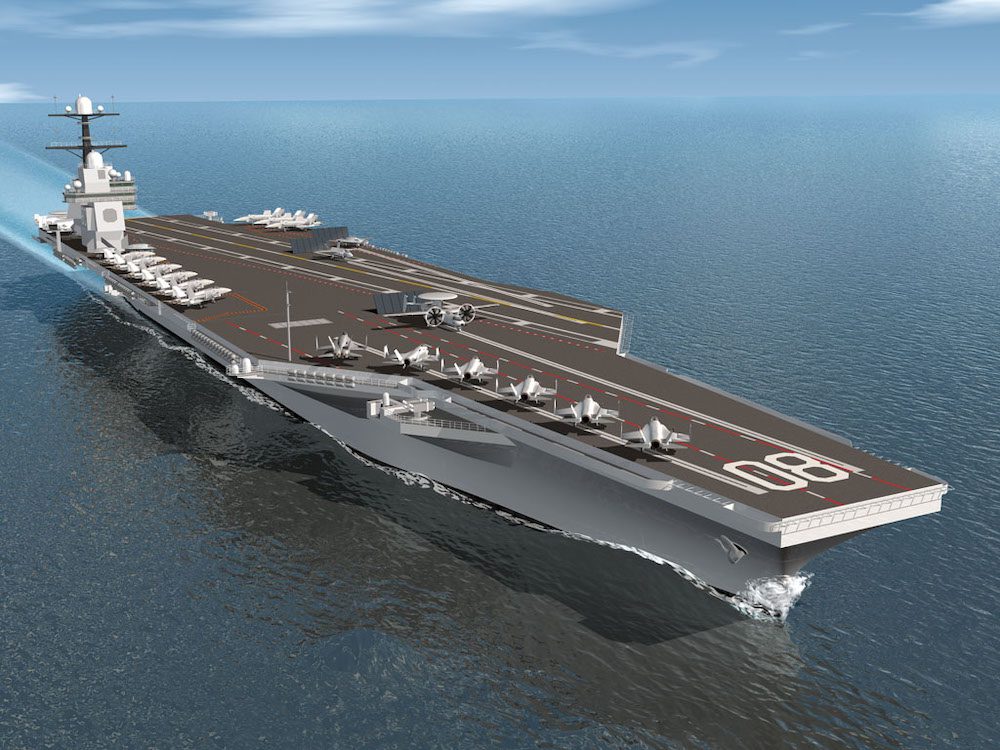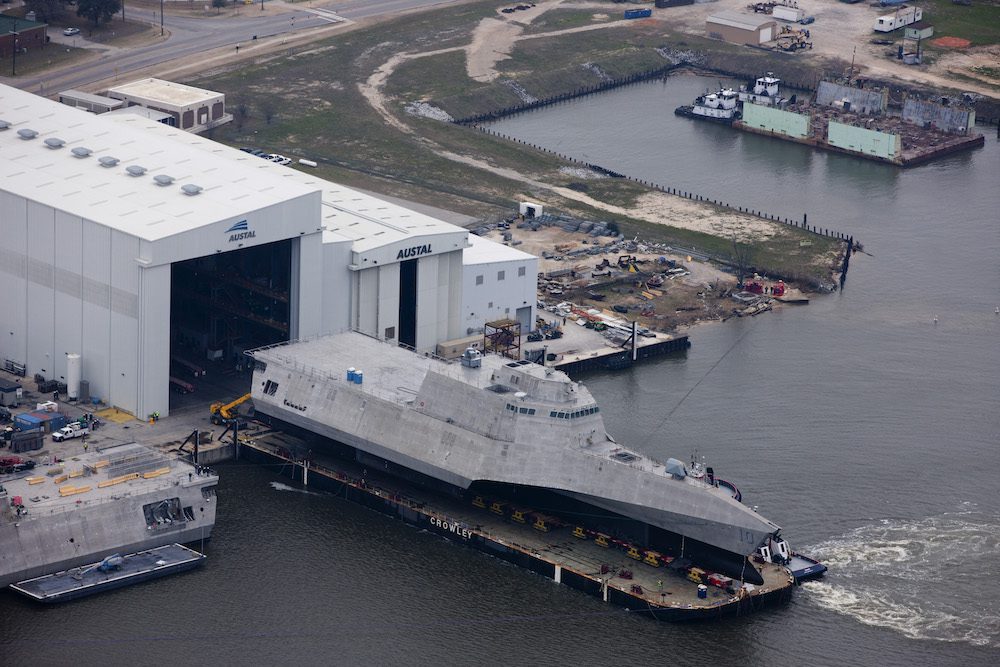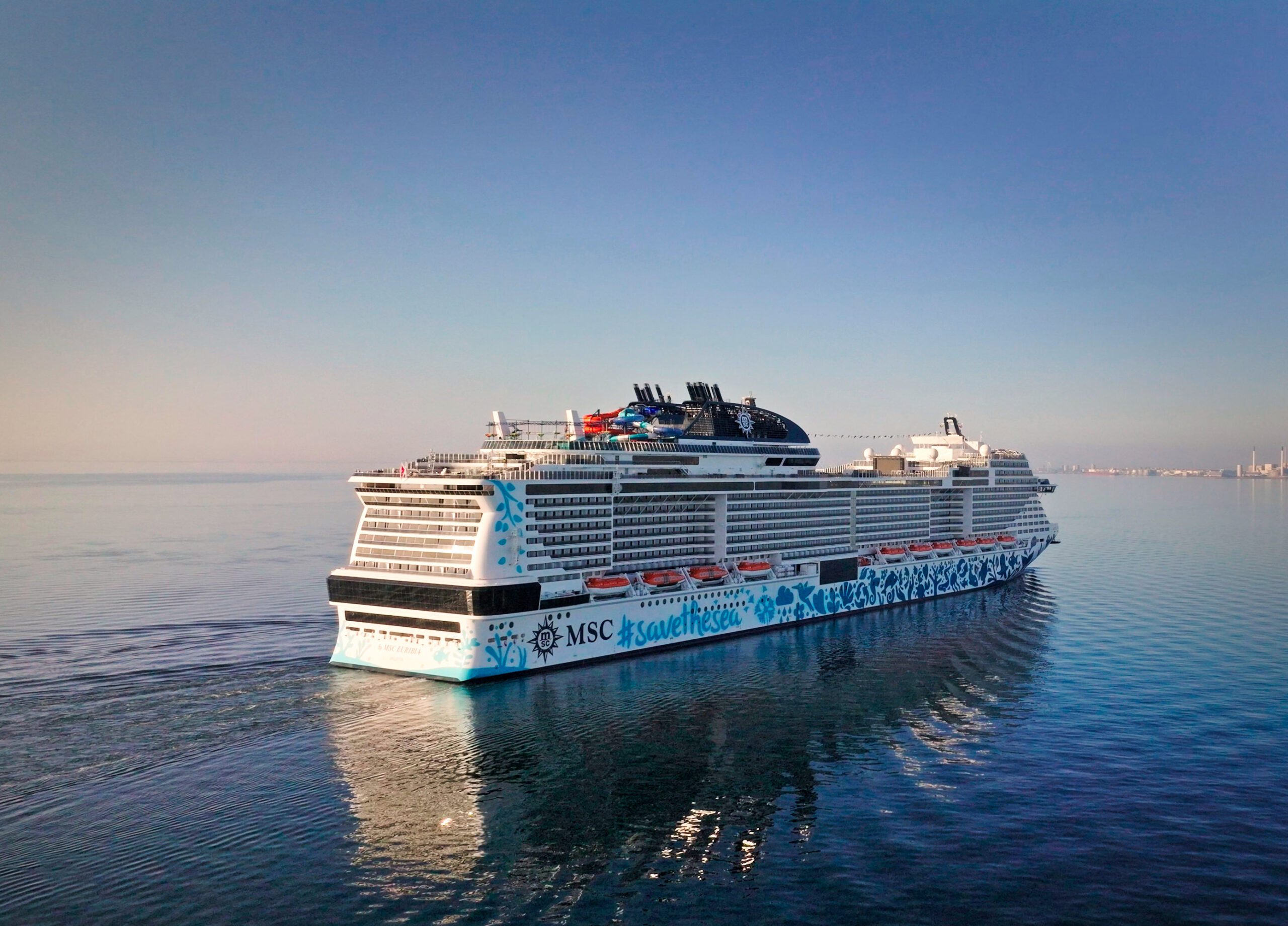by Troy Bouffard (Guest Post) – The United States has a chronic shipbuilding problem: since the 1980s, the construction of large military vessels has significantly and consistently exceeded time and budget estimations. The past 15 years of major U.S. military shipbuilding programs have revealed consistent patterns of schedule delays and cost overruns across all vessel classes.
As the U.S. shipbuilding industry continues to face delays and cost overruns, the integration of AI technology presents a promising path forward. Rather than replacing human expertise, AI should be considered as a crucial tool for augmenting human capabilities in areas where traditional approaches fall short.
The Gerald R. Ford-class aircraft carrier program exemplifies the U.S.’ challenges, with the lead ship suffering from multi-year delays and billions in cost growth due to new technology integration issues. Similar patterns emerged across submarine programs, with both Virginia-class and Columbia-class submarines facing extensive delays caused by supply chain disruptions and workforce limitations.
The Coast Guard’s Polar Security Cutter program has encountered its own set of challenges, which have been exacerbated by complexity of Arctic-capable vessel design and limited U.S. shipyard experience with icebreaker construction.
The Zumwalt-class destroyer program saw repeated timeline extensions and eventual program truncation, while the Littoral Combat Ship program faced persistent delays related to design changes and mission package development. Even relatively straightforward vessels like the John Lewis-class fleet replenishment oilers have necessitated schedule slippage.
Across these programs, initial timeline estimates have typically extended by 30-60%, with cost growth often ranging from 25% to well over 100% of original estimates.
These delays have been particularly impactful for critical national security assets like the Columbia-class submarines, where delays in platform delivery undermine the U.S. capacity to sustain strategic deterrence.
Recently, a Congressional report has presented various problems involving shipbuilding capacity and delays as well as notable observations and options.
Modern shipbuilding is a massive undertaking that involves thousands of workers, millions of parts, and years of precise coordination. A large military vessel requires synchronized effort across seven major stages of production: design and engineering, material procurement, hull construction, outfitting, systems integration, testing and commissioning, and sea trials. The scale of even a single ship is staggering. An aircraft carrier in the Gerald R. Ford-class involves over 47,000 tons of steel, more than 5,000 workers, and typically takes 5-7 years to complete under optimal conditions. Each step in the process presents potential bottlenecks that can cascade into major delays.
Rather than replacing human expertise, AI should be considered as a crucial tool for augmenting human capabilities in areas where traditional approaches fall short.
An advanced AI system could assist in multiple critical areas of ship building, with specific focus toward managing complexity; sequencing and supply chain optimization; and predictive analytics for integration and testing.
The following list offers examples of AI/ML applications for major phases of shipbuilding.
Design and Engineering Phase: Modern warships require extensive computer modeling, simulation, and analysis before construction begins. The integration of new technologies, like the electromagnetic aircraft launch system in the Ford-class carriers, can add years to this phase as designs are refined and tested virtually. AI can optimize ship designs through complex simulations and performance predictions. Machine learning algorithms can analyze vast amounts of historical data to inform better design decisions and predict potential integration challenges before they occur, which could minimize the number of “trials and errors” later in production.
Material Procurement: Military vessels require specialized materials that often have limited suppliers. A single Virginia-class submarine contains over 1 million individual parts from thousands of suppliers. Supply chain disruptions for even seemingly minor components can halt entire production lines, which can then cause compounding delays throughout the remainder of the shipbuilding process. AI systems can predict disruptions, optimize inventory levels, and suggest alternative suppliers based on real-time global economic trends and geopolitical events. This proactive approach could help prevent the types of supply chain issues that have plagued programs like the Columbia-class submarines.
Hull Construction: The basic hull structure involves cutting, shaping, and welding massive steel plates. Modern ships are built in sections called blocks, which can weigh hundreds of tons each. These blocks must be precisely manufactured to fit together – any misalignment can cause appreciable amounts of rework. Quality control and inspection can benefit from AI-powered significant computer vision systems performing automated inspections and detecting defects with high accuracy. Machine learning models can also predict potential quality issues before they occur, potentially preventing the types of performance issues that delayed the Littoral Combat Ships program.
Outfitting: This phase involves installing everything from pipes and electrical systems to crew quarters and equipment. The Zumwalt-class destroyers, for example, were designed with over 35 miles of cable and piping. Coordination between different trades at this phase is crucial, as work often needs to be completed in a specific sequence within confined spaces. AI/ML integrations could ostensibly aid managers in deconflicting schedules to minimize white space on production timelines.
Systems Integration: Modern warships are essentially floating cities with complex networks of interrelated systems, such as combat systems, radar, and communications suites. The integration of these and other electronic systems has become increasingly challenging as ships become more technologically sophisticated. AI/ML applications would improve.
Testing and Commissioning: Each system must be thoroughly tested both individually in a standalone capacity and again as part of the integrated whole. The Littoral Combat Ships program demonstrated how issues discovered during this phase of testing can force a “return to the drawing board” for design changes and lead to significant delays as a result.
Sea Trials: The final phase involves comprehensive testing at sea to verify all systems work as intended under real-world conditions. Problems identified during this phase – like those experienced with the Ford’s advanced arresting gear system – can necessitate multiple cycles of modification and follow-on trials.
Throughout all phases of production planning, AI can create and dynamically adjust optimal production schedules by calculating for resource constraints, dependencies, and deadlines. This could help address the production inefficiencies seen in programs like the San Antonio-class amphibious transport docks.
Implementing AI solutions in shipbuilding requires careful consideration. The ideal approach would be a human-AI collaboration, where AI handles data analysis, optimization, and prediction, while humans provide strategic direction and address the challenges that require nuanced understanding.
The integration of AI systems would require substantial investments in technology infrastructure, data collection and management, and workforce training. It would also necessitate careful attention to cybersecurity to prevent introducing new vulnerabilities into critical defense industries.
The above capabilities can be options adopted by industry, perhaps as requirements in some cases. At the very least, more accurate timeline estimations will help manage expectations and minimize the impacts to planning caused by delays in shipbuilding.
In particular, the U.S. Navy’s Program Executive Offices (PEOs), Naval Sea Systems Command (NAVSEA), the Office of the Chief of Naval Operations (OPNO), and the Maritime Industrial Base Program Office could significantly benefit from an AI-powered tool designed specifically for solicitation development and application review.
Such a tool could analyze historical shipbuilding data to compare proposed timelines and budgets against actual performance across decades of naval procurement. For solicitation development, an AI system could flag potential risks based on past program performance, identify unrealistic schedule assumptions, and suggest more achievable milestone targets based on empirical data.
The system could also support proposal review by assessing vendor claims against historical performance metrics, evaluate the realism of proposed technical approaches, and analyze supply chain vulnerabilities that might impact schedule performance. This would provide government acquisition professionals with data-driven insights to strengthen solicitation requirements and more accurately evaluate contractor proposals.
The tool could be particularly valuable in identifying systemic issues that have led to delays across multiple programs – such as overoptimistic technology readiness assumptions or underestimated integration challenges – thereby helping program offices develop more realistic acquisition strategies from the outset.
As the U.S. shipbuilding industry continues to face delays and cost overruns, the integration of AI technology presents a promising path forward. AI/ML applications are not a panacea, but rather tools to manage the complexity that has overwhelmed traditional approaches to shipbuilding management. By augmenting human capabilities with artificial intelligence, the industry could better navigate the challenges of modern shipbuilding while maintaining the crucial human element in strategic decision-making and complex problem-solving.
Dr. Bouffard is an Asst. Professor at the University of Alaska Fairbanks. He has a Ph.D. in Arctic Defense and Security. He is currently a research fellow with the Modern War Institute – West Point and a former congressional fellow and Arctic Advisor in the U.S. Senate.

 Join The Club
Join The Club











